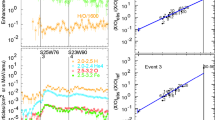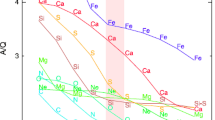Abstract
We study the abundances of the elements He through Pb in Fe-rich impulsive solar energetic-particle (SEP) events with measurable abundances of ions with atomic number Z>2 observed on the Wind spacecraft, and their relationship with coronal mass ejections (CMEs) observed by the Large Angle and Spectrometric Coronagraph (LASCO) onboard the Solar and Heliospheric Observatory (SOHO). On an average the element abundances in these events are similar to coronal abundances at low Z but, for heavier elements, enhancements rise as a power law in the mass-to-charge ratio A/Q of the ions (at coronal temperatures of 2.5 – 3 MK) to a factor of 3 at Ne, 9 at Fe, and 900 for 76≤Z≤82. Energy dependences of abundances are minimal in the 2 – 15 MeV amu−1 range. The 111 of these Fe-rich impulsive SEP events we found, between November 1994 and August 2013 using the Wind spacecraft, have a 69 % association rate with CMEs. The CMEs are narrow with a median width of 75∘, are characteristically from western longitudes on the Sun, and have a median speed of ≈ 600 km s−1. Nearly all SEP onsets occur within 1.5 – 5 h of the CME onset. The faster (> 700 km s−1), wider CMEs in our sample are related to SEPs with coronal abundances indicating hot coronal plasma with fully ionized He, C, N and O and moderate enhancements of heavier elements, relative to He, but slower (< 700 km s−1), narrower CMEs emerge from cooler plasma where higher SEP mass-to-charge ratios, A/Q, yield much greater abundance enhancements, even for C/He and O/He. Apparently, the open magnetic-reconnection region where the impulsive SEPs are accelerated also provides the energy to drive out CME plasma, accounting for a strong, probably universal, impulsive SEP-CME association.














Similar content being viewed by others
References
Archontis, V., Hood, A.W.: 2013, Astrophys. J. Lett. 769, L21.
Arnaud, M., Raymond, J.: 1992, Astrophys. J. 398, 394.
Arnaud, M., Rothenflug, R.: 1985, Astron. Astrophys. Suppl. 60, 425.
Bougeret, J.-L., Kaiser, M.L., Kellogg, P.J., Manning, R., Goetz, K., Monson, S.J., et al.: 1995, Space Sci. Rev. 71, 5.
Brueckner, G.E., Howard, R.A., Koomen, M.J., Korendyke, C.M., Michels, D.J., Moses, J.D., et al.: 1995, Solar Phys. 162, 357.
Cliver, E.W., Kahler, S.W., Reames, D.V.: 2004, Astrophys. J. 605, 902.
Cliver, E.W., Ling, A.G.: 2007, Astrophys. J. 658, 1349.
Cliver, E.W., Ling, A.G.: 2009, Astrophys. J. 690, 598.
Cohen, C.M.S., Mewaldt, R.A., Leske, R.A., Cummings, A.C., Stone, E.C., Wiedenbeck, M.E., von Rosenvinge, T.T., Mason, G.M.: 2007, Space Sci. Rev. 130, 183.
Desai, M.I., Mason, G.M., Dwyer, J.R., Mazur, J.E., Gold, R.E., Krimigis, S.M., Smith, C.W., Skoug, R.M.: 2003, Astrophys. J. 588, 1149.
Desai, M.I., Mason, G.M., Wiedenbeck, M.E., Cohen, C.M.S., Mazur, J.E., Dwyer, J.R., et al.: 2004, Astrophys. J. 661, 1156.
Desai, M.I., Mason, G.M., Gold, R.E., Krimigis, S.M., Cohen, C.M.S., Mewaldt, R.A., Mazur, J.E., Dwyer, J.R.: 2006, Astrophys. J. 649, 740.
DiFabio, R., Guo, Z., Möbius, E., Klecker, B., Kucharek, H., Mason, G.M., Popecki, M.: 2008, Astrophys. J. 687, 623.
Drake, J.F., Cassak, P.A., Shay, M.A., Swisdak, M., Quataert, E.: 2009, Astrophys. J. Lett. 700, L16.
Drake, J.F., Swisdak, M.: 2012, Space Sci. Rev. 172, 227.
Ganse, U., Kilian, P., Vainio, R., Spanier, F.: 2012, Solar Phys. 280, 551.
Garcia, H.A.: 1994, Astrophys. J. 420, 422.
Gosling, J.T.: 1993, J. Geophys. Res. 98, 18937.
Gopalswamy, N., Yashiro, S., Michalek, G., Kaiser, M.L., Howard, R.A., Reames, D.V., Leske, R., von Rosenvinge, T.: 2002, Astrophys. J. Lett. 572, L103.
Gopalswamy, N., Yashiro, S., Michalek, G., Stenborg, G., Vourlidas, A., Freeland, S., Howard, R.: 2009, Earth Moon Planets 104, 295.
Kahler, S.W.: 1992, Annu. Rev. Astron. Astrophys. 30, 113.
Kahler, S.W.: 1994, Astrophys. J. 428, 837.
Kahler, S.W.: 2001, J. Geophys. Res. 106, 20947.
Kahler, S.W., Reames, D.V., Sheeley, N.R., Jr.: 2001, Astrophys. J. 562, 558.
Kahler, S.W., Sheeley, N.R., Jr., Howard, R.A., Koomen, M.J., Michels, D.J., McGuire, R.E., von Rosenvinge, T.T., Reames, D.V.: 1984, J. Geophys. Res. 89, 9683.
Knizhnik, K., Swisdak, M., Drake, J.F.: 2011, Astrophys. J. Lett. 743, L35.
Lee, M.A.: 1997, In: Crooker, N., Jocelyn, J.A., Feynman, J. (eds.) Coronal Mass Ejections, AGU Geophys. Monogr. 99, 227.
Lee, M.A.: 2005, Astrophys. J. Suppl. 158, 38.
Leske, R.A., Mewaldt, R.A., Cohen, C.M.S., Cummings, A.C., Stone, E.C., Wiedenbeck, M.E., von Rosenvinge, T.T.: 2007, Space Sci. Rev. 130, 195.
Luhn, A., Klecker, B., Hovestadt, D., Gloeckler, G., Ipavich, F.M., Scholer, M., Fan, C.Y., Fisk, L.A.: 1984, Adv. Space Res. 4, 161.
Mason, G.M., Gloeckler, G., Hovestadt, D.: 1979, Astrophys. J. Lett. 231, L87.
Mason, G.M., Mazur, J.E., Dwyer, J.R.: 1999, Astrophys. J. Lett. 525, L133.
Mason, G.M., Mazur, J.E., Dwyer, J.R.: 2002, Astrophys. J. Lett. 565, L51.
Mason, G.M., Reames, D.V., Klecker, B., Hovestadt, D., von Rosenvinge, T.T.: 1986, Astrophys. J. 303, 849.
Meyer, J.P.: 1985, Astrophys. J. Suppl. 57, 151.
Moore, R.L., Cirtain, J.W., Sterling, A.C., Falconer, D.A.: 2010, Astrophys. J. 720, 757.
Ng, C.K., Reames, D.V., Tylka, A.J.: 2003, Astrophys. J. 591, 461.
Ng, C.K., Reames, D.V.: 2008, Astrophys. J. Lett. 686, L123.
Nitta, N.V., Reames, D.V., DeRosa, M.L., Yashiro, S., Gopalswamy, N.: 2006, Astrophys. J. 650, 438.
Post, D.E., Jensen, R.V., Tarter, C.B., Grasberger, W.H., Lokke, W.A.: 1977, At. Data Nucl. Data Tables 20, 397.
Reames, D.V.: 1990, Astrophys. J. Suppl. 73, 235.
Reames, D.V.: 1995a, Adv. Space Res. 15, 41.
Reames, D.V.: 1995b, Rev. Geophys. 33, 585.
Reames, D.V.: 1999, Space Sci. Rev. 90, 413.
Reames, D.V.: 2000, Astrophys. J. Lett. 540, L111.
Reames, D.V.: 2002, Astrophys. J. Lett. 571, L63.
Reames, D.V.: 2013, Space Sci. Rev. 175, 53.
Reames, D.V.: 2014, Solar Phys. 289, 977.
Reames, D.V., Meyer, J.P., von Rosenvinge, T.T.: 1994, Astrophys. J. Suppl. 90, 649.
Reames, D.V., Ng, C.K., Berdichevsky, D.: 2001, Astrophys. J. 550, 1064.
Reames, D.V., Ng, C.K.: 2004, Astrophys. J. 610, 510.
Reames, D.V., Barbier, L.M., von Rosenvinge, T.T., Mason, G.M., Mazur, J.E., Dwyer, J.R.: 1997, Astrophys. J. 483, 515.
Roth, I., Temerin, M.: 1997, Astrophys. J. 477, 940.
Rouillard, A.C., Odstrčil, D., Sheeley, N.R., Jr., Tylka, A.J., Vourlidas, A., Mason, G., Wu, C.-C., Savani, N.P., Wood, B.E., Ng, C.K., et al.: 2011, Astrophys. J. 735, 7.
Rouillard, A., Sheeley, N.R., Jr., Tylka, A., Vourlidas, A., Ng, C.K., Rakowski, C., Cohen, C.M.S., et al.: 2012, Astrophys. J. 752, 44.
Sandroos, A., Vainio, R.: 2009, Astron. Astrophys. 507, L21.
Shimojo, M., Shibata, K.: 2000, Astrophys. J. 542, 1100.
Slocum, P.L., Stone, E.C., Leske, R.A., Christian, E.R., Cohen, C.M.S., Cummings, A.C., et al.: 2003, Astrophys. J. 594, 592.
Temerin, M., Roth, I.: 1992, Astrophys. J. Lett. 391, L105.
Tylka, A.J.: 2001, J. Geophys. Res. 106, 25333.
Tylka, A.J., Lee, M.A.: 2006, Astrophys. J. 646, 1319.
Tylka, A.J., Cohen, C.M.S., Dietrich, W.F., Lee, M.A., Maclennan, C.G., Mewaldt, R.A., Ng, C.K., Reames, D.V.: 2005, Astrophys. J. 625, 474.
von Rosenvinge, T.T., Barbier, L.M., Karsch, J., Liberman, R., Madden, M.P., Nolan, T., et al.: 1995, Space Sci. Rev. 71, 155.
Wang, Y.-M., Pick, M., Mason, G.M.: 2006, Astrophys. J. 639, 495.
Wang, L., Lin, R.P., Krucker, S., Mason, G.M.: 2012, Astrophys. J. 759, 69.
Wiedenbeck, M.E., Cohen, C.M.S., Leske, R.A., Mewaldt, R.A., Cummings, A.C., Stone, E.C., von Rosenvinge, T.T.: 2010, Astrophys. J. 719, 1212.
Yashiro, S., Gopalswamy, N., Cliver, E.W., Reames, D.V., Kaiser, M., Howard, R.: 2004a, In: Sakurai, T., Sekii, T. (eds.) The Solar-B Mission and the Forefront of Solar Physics, ASP Conf. Ser. 325, 401.
Yashiro, S., Gopalswamy, N., Michalek, G., St. Cyr, O.C., Plunkett, S.P., Rich, N.B., Howard, R.A.: 2004b, J. Geophys. Res. 109, A07105.
Acknowledgements
S.K. and E.C. were funded by AFOSR Task 2301RDZ4. CME data were taken from the CDAW LASCO catalog. This CME catalog is generated and maintained at the CDAW Data Center by NASA and The Catholic University of America in cooperation with the Naval Research Laboratory. SOHO is a project of international cooperation between ESA and NASA. We acknowledge the use of the Wind/WAVES data.
Author information
Authors and Affiliations
Corresponding author
Appendix
Appendix
Table 2 lists properties of 111 Fe-rich impulsive SEP events. Columns in the table are the event number, the SEP onset time, the SEP event duration (Dur.), the abundance ratios of Fe/O, Ne/O, and He/O at 3 – 4 MeV amu−1, the ratio (50≤Z≤56)/O at 3 – 10 MeV amu−1, the associated CME speed, V, the central position angle (CPA) and width (W) of the CME, the delay between the CME onset and the SEP onset, the UT onset time of the DH type III burst (* indicates previous day), the presence of a DH type II radio burst, and the location of associated flare or other source. NA in the CME speed indicates that no LASCO coronagraph data were available, dash indicates that data were available but no CME was listed.
Rights and permissions
About this article
Cite this article
Reames, D.V., Cliver, E.W. & Kahler, S.W. Abundance Enhancements in Impulsive Solar Energetic-Particle Events with Associated Coronal Mass Ejections. Sol Phys 289, 3817–3841 (2014). https://doi.org/10.1007/s11207-014-0547-1
Received:
Accepted:
Published:
Issue Date:
DOI: https://doi.org/10.1007/s11207-014-0547-1




